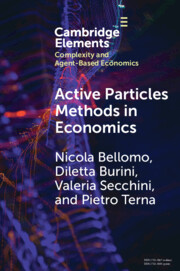Active Particles Methods in Economics
New Perspectives in the Interaction between Mathematics and Economics
Published online by Cambridge University Press:
22 November 2024
- Nicola Bellomo
- Affiliation:
Universidad de Granada
- Diletta Burini
- Affiliation:
Liceo statale classico e musicale ‘A. Mariotti’
- Valeria Secchini
- Affiliation:
Charles University, Prague
- Pietro Terna
- Affiliation:
Università di Torino, Italy
Summary
The aim of this Element is to understand how far mathematical theories based on active particle methods have been applied to describe the dynamics of complex systems in economics, and to look forward to further research perspectives in the interaction between mathematics and economics. The mathematical theory of active particles and the theory of behavioural swarms are selected for the above interaction. The mathematical approach considered in this work takes into account the complexity of living systems, which is a key feature of behavioural economics. The modelling and simulation of the dynamics of prices within a heterogeneous population is reviewed to show how mathematical tools can be used in real applications.

